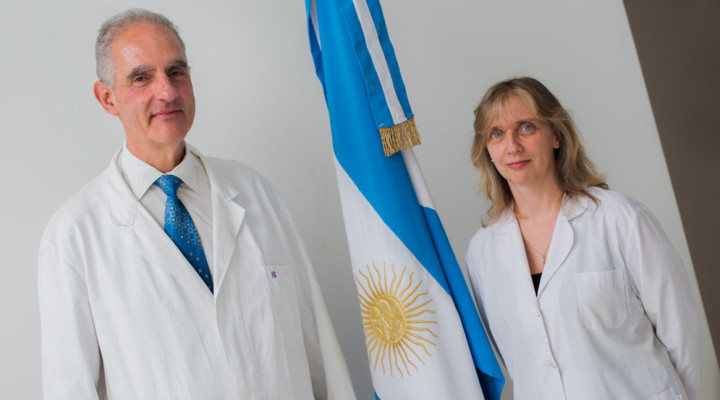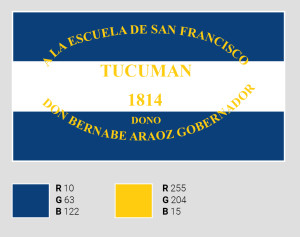EXACT AND NATURAL SCIENCES
Azul un ala
CONICET chemists analyzed one the oldest Argentine flags and revealed the original color of its upper and lower end: ultramarine blue
On February 1812, and from November in previous year, Manuel Belgrano, chief of the Regimiento de Patricios [Patrician Regiment] was in Rosario, on the riverbank of Río Paraná, in charge of the Independence and Libertad troops to halt the possible advances of the royalist forces from Montevideo. At that time, due to the need to distinguish the local troops from the enemies, Belgrano created the “escarapela” [cockade] and hoisted for the first time the flag that after some time became the official Argentine flag. Later on, another member of the Primera Junta [First Assembly] went to the province of Jujuy to lead the Ejército Auxiliar del Perú.
The colors of that flag are still a reason of historical debates: while some people affirm that it was white and light blue (that is to say, the tone that we know under that name), others reply that it was white and blue. In order to contribute to that controversy, CONICET scientists at the Centro de Química Inorgánica (CEQUINOR, CONICET-UNLP) together with researchers of the Universidade Federal de Juiz de Fora (Brazil) analyzed spectroscopically and chemically the strands of the oldest flag preserved, the one of the San Francisco Temple in the province of Tucumán. After the study, the scientists concluded that the upper and the lower ends of the flag were blue, a tone corresponding to the pigment Ultramarine blue.
That flag in question was ordered by Bernabé Aráoz, the first governor mayor of Tucumán and trustee of the San Francisco Temple in that province. In that flag, it was written in yellow capital letter: ‘A la Escuela de San Francisco, Tucumán 1814, Donó Bernabé Aráoz’ [To San Francisco School, Tucumán 1814, Donated by Bernabé Aráoz]’. The researchers also determined that the material of the paint used in that inscription was crocoite, a lead chromate mineral (PbCrO4).
“Although this is not the flag that was hoisted in February 1812 on the riverbank of Río Paraná, there are reasons to believe that Aráoz must have taken the model of its creator, who was a close person to him. It was the man from Tucumán that after the Éxodo Jujeño had convinced him in La Encrucijada to face the royal troops in his province and not in Córdoba, as the Primer Trinvirato had ordered. Furthermore, Aráoz received laudatory comments of the chief of the Ejército del Norte after the Battle of Salta in February 1813”, Carlos Della Védova affirms. He is a CONICET senior researcher, director of the CEQUINOR, and leading member of the recent study published in Chemistry Select.
This study revealed a third piece of information: the flag donated to the Escuela de San Francisco was made of silk. Of course that the flag preserved in Tucumán and the samples the researchers could take are far from keeping their original color.
“Today they are practically colorless due to the damage resulting after the light and the atmosphere in Tucumán over the years. The dust generated by sugar cane harvest became current witness of the pollution this relic was exposed to”, Della Védova explains.
So the researchers had to project the original colors through the detection of the samples’ components by means of x-ray fluorescence, Raman spectroscopy and chemical analysis.
“We exposed one strand of the flag to the relatively concentrated hydrochloric acid attack and noticed how all the components of the ultramarine blue decreased”, the researcher comments.
The scientists managed to project a code for the color of the ends of the flag and the one of the yellow inscription on the RGB –Red, Green and Blue– scale. This model can represent colors from the coordinates that take into account figures in the addition of the three primary light colors. While the figures of the ultramarine blue are R: 10, G: 63 and B: 122, the ones of the chrome yellow letters are R: 255, G: 204 and B: 15.
Finally, the analysis of the materials also allowed researchers to determine that the flag had had treatments done to protect it from the corrosive effects of time. “We managed to prove that it had been uniformly treated with one tin salt. This must have been done to protect it from, for example, the attack of the moths. Furthermore, it also agrees with what Cecilia Barrionuevo –the person who had helped us to take the samples– who said that the flag had been treated to protect it”, Della Védova comments.
Barrionuevo is the restorer of the Casa Histórica de la Independencia in Tucumán and she estimates that the flag must have been around 70 years in the San Francisco Temple, next to the altar, until 2012 when it was lowered to be treated. “It was wrinkled because the frame was smaller than the flag, but it was placed in a way that showed the date and the place of the inscription”, she explains. The restorer also adds that there are records that show that it had been patched with a piece of cloth in order to consolidate it.
Ultimately, the analysis through x-ray fluorescence, Raman spectroscopy and chemical analysis of one strand of a historical piece such as the Argentine flag of the San Francisco Temple allowed the researchers to determine accurate information on this object –the material used to make it, the original color of the ends, the inscription and the type of treatment it had to be preserved-, but it mainly helps to infer how was the flag hoisted by Belgrano on the riverbank of Paraná River in 1812.
It was ultramarine blue and white.
Click here to watch the video.
“As I knew about the existence of the flag in the San Francisco Church in Tucumán, on November 22nd 2013 I decided to talk to Fray Marcos Porta Aguilar, the Franciscan guardian of the Church, because on that day my appointment as a Professor of the Universidad Nacional de Tucumán was published in the newspapers and my unexpected visit and my unusual proposal of seeking access to a historical relic, would have some sort of support. Then, this story began with the invaluable collaboration of father Marcos and Cecilia Barrionuevo”, Della Védova describes.
By Miguel Faigón
About the study:
Rosana M. Romano. Principal researcher. CEQUINOR.
Rodrigo Stephani. Universidade Federal de Juiz Fora.
Luis F. Cappa Oliveira. Universidade Federal de Juiz Fora.
Carlos Della Védova. Senior researcher. CEQUINOR

